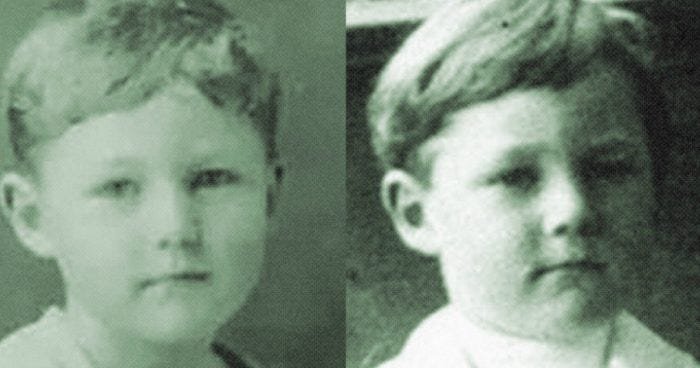What would you do if as you lay alone at night, a voice whispered terrible things in your ear, no matter how hard you tried to silence it?
This was supposedly the reality for Edward Mordrake, the subject of an urban legend that details his experience with a second face on the back of his head.


But was Edward Mordrake a real person? Can someone truly have a face on the back of their head?
Who Was Edward Mordrake?
As the legend goes, Mordrake was a well-off son born into a wealthy, upper-class English family. He was handsome enough to be compared to Antinous, the young lover of Roman Emperor Hadrian, and a musical prodigy.
By all accounts, he had an easy life. That is, except for the second face that he had on the back of his head. This second face, which was female, was described as simply having a pair of eyes and a drooling mouth.
However, even with such simplistic features, the face seemed devilish in nature, showing every sign of intelligence, “but of a malignant sort.”
The story holds that the face would sneer when Mordrake was happy and bear a wide smile when he was sad, clearly reveling in his anguish.
Mordrake himself claimed that the face would whisper to him in the night, saying things “one would only speak of in hell,” although nobody else ever heard the face utter a word.
He begged doctors to remove the face so that he could finally sleep in peace, but no doctor was willing to take the risk.
Mordrake fully secluded himself away from his loved ones, and by age 23, he could no longer tolerate the torment brought on by his other face’s whispers, and he took his own life.
In the letter he left, he begged doctors to remove the face from his body so that it could not continue to haunt him in his grave.
The Beginnings Of A Legend
Mordrake’s story first appeared in The Boston Post in 1895 as an article written by reporter Charles Lotin Hildreth. Hildreth was a science fiction author, not a doctor, who is now theorized to have created the story to drive reader engagement with the newspaper.
Along with Mordrake, the article details other “human freaks”, such as a man with spider legs and a man who was half crab. The article was a hit, spreading the tale of Mordrake and other unfortunate souls like wildfire across the United States.
Even medical professionals accepted the story at face value, intrigued by the premise that a person could have a second human face that communicated with them.
How Did Edward Mordrake Have Two Heads?
Since Mordrake’s body has never been found or officially autopsied, it is impossible to know exactly what condition he suffered from. A copy of his story can be found in the 1896 edition of the medical encyclopedia Anomalies and Curiosities of Medicine.
This record is almost an exact replica of the one from The Boston Post, which demonstrates just how convincing and influential Hildreth’s article was.
While the doctors who authored the encyclopedia were trustworthy and practicing medical professionals, they did little to check the validity of the tale: their only citation for Mordrake’s story was Hildreth’s article, and they did no other peer review.

Regardless, medical professionals were fascinated with the tale and attempted to rationalize the condition. Based on the description available in the article alone, doctors have offered their theories on what condition Mordrake may have suffered from.
The first potential explanation is craniopagus parasiticus, which is a form of parasitic twinning that only occurs 2-3 times per 5 million twin births.
In this scenario, the second twin fails to develop a full body of its own; instead, it survives as a second head attached to the fully developed body.
Even today, doctors are unaware of how this kind of development occurs since there have been fewer than a dozen cases ever recorded.
More broadly, parasitic twinning in general could be an explanation, where development stops just short of having two fully developed twins. Instead, one twin becomes dependent on the other for survival due to incomplete development, but otherwise, is healthy.
Another explanation could be diprosopus. This is a condition that onlookers commonly assume to be conjoined twins, but actually is unrelated to the development of the embryo in utero; instead, it is the result of an abnormality in protein development.
An overabundance of the sonic hedgehog (SHH) protein (named after the videogame character) can create a duplicate facial structure during embryonic development.
Scientists have been able to replicate the condition in baby chicks by supplying an abundance of SHH protein, which grows a second beak on their faces.
Of course, even if doctors are able to rationalize the existence of Mordrake’s second head, there is no reasonable explanation that can explain why Mordrake’s other head would be as evil as the stories claim.
Unveiling The Hoax Of Edward Mordrake
In recent years, the story of Mordrake has been proven false. In 2015, a historian at the Museum of Hoaxes committed to researching the story of Mordrake and uncovering the truth behind the unbelievable tales documented there.
The English “Royal Scientific Society,” which Hildreth cited as the authority on Mordrake’s story, is an organization that did not exist until the 1970s but sounded official enough to trick readers in the United States at the time.
The Royal Society of London did exist, and there were many groups with the word “scientific” in the name, but none with both.
After diving into the archives of the Royal Society of London, no record of Mordrake exists there, meaning it was not a case of miscitation.
Finally, another minor detail that invalidates the tale is that the story relates Mordrake’s second face as female, although all cases of parasitic twins require both twins to be the same sex.
The Reemergence Of Mordrake’s Tale
While the tale may be fake, the legacy of Mordrake has persisted and regained popularity in the 21st century.

In part, society has always been intrigued by “freaks.” Circuses and “freak shows” toured the country regularly in the 19th and 20th centuries, placing on display medical anomalies for show.
This was horribly dehumanizing for those in the shows, although in many cases, their peers within the show were the most accepting community any of them could find.
In 2014, the FX show American Horror Story aired a season called Freak Show based around this premise, within which Mordrake was a character in a two-part episode alongside other deformed people.
Some of the characters from the show, such as a man who is part crab, were also drawn from the same article from The Boston Post.
In these episodes, Mordrake is driven to murder as well as suicide by the voice emanating from the back of his head, harkening back to the origin of his tale.
The popularity of the show and the reemergence of Mordrake in the public eye may have been what inspired the 2015 investigation by the Museum of Hoaxes.
Just a few years after the show aired, a wax figurine of a head with a face emerging from the back went viral on the internet. The image was paired with a short summation of Mordrake’s story, and the morbid combination intrigued thousands.
The wax figurine was convincing enough that people truly believed the image was of Mordrake’s head, not a replica based on the story.
Of course, stories debunking the image were shared, but not nearly as many people heard about the 2015 investigation, which declared Mordrake a hoax.
Despite being disproven, the public was once again fooled in 2018 when a picture arose of a skull that had a face emerging from the back of it.
Created by Ewart Schindler, the picture became popular when it was shared on a popular Facebook page that supposedly shows history through pictures, where they claimed the photograph was legitimate evidence of Mordrake’s condition.
Schindler confirms that the image is a gaff, or a joke art piece, crafted of papier-mâché and used explicitly to entertain onlookers. Traveling shows often used these pieces to advertise freaks of nature, like the famous Fiji mermaid.
In the era of unsubstantiated claims and rapid, viral discourse, Edward Mordrake’s story is able to be shared with more fervor and belief than when it was released.
Although his existence has been proven false based on the lack of legitimacy in the article sharing his tale, it is difficult to prove a negative, and people continue to believe in Mordrake’s tragic story to this day.
Since there are legitimate medical conditions doctors are aware of today that could rationalize the tale of Mordrake and no physical evidence to confirm or deny his condition, the world will forever be haunted by the chance of the specter of a second face whispering unspeakable evils to a poor man in his bed.
Sources
https://www.newsweek.com/edward-mordrakes-mummified-head-fools-internet-actually-gaff-911179
https://hoaxes.org/weblog/comments/edward_mordake













Leave a comment